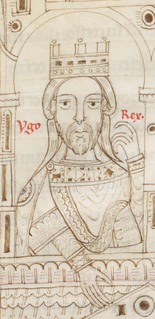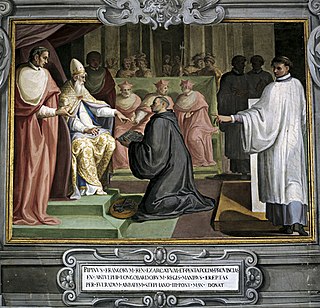Related Research Articles
Pope Alexander II, born Anselm of Baggio, was the head of the Roman Catholic Church and ruler of the Papal States from 1061 to his death in 1073. Born in Milan, Anselm was deeply involved in the Pataria reform movement. Elected according to the terms of his predecessor's bull, In nomine Domini, Anselm's was the first election by the cardinals without the participation of the people and minor clergy of Rome.
Pope Honorius II, born Lamberto Scannabecchi, was head of the Catholic Church and ruler of the Papal States from 21 December 1124 to his death in 1130.

Pope Gregory IV was the bishop of Rome and ruler of the Papal States from October 827 to his death. His pontificate was notable for the papacy’s attempts to intervene in the quarrels between Emperor Louis the Pious and his sons. It also saw the breakup of the Carolingian Empire in 843.

Pope Innocent II, born Gregorio Papareschi, was head of the Catholic Church and ruler of the Papal States from 14 February 1130 to his death in 1143. His election as pope was controversial and the first eight years of his reign were marked by a struggle for recognition against the supporters of Anacletus II. He reached an understanding with King Lothair III of Germany who supported him against Anacletus and whom he crowned as Holy Roman emperor. Innocent went on to preside over the Second Lateran council.

Lothair III, sometimes numbered Lothair II and also known as Lothair of Supplinburg, was Holy Roman Emperor from 1133 until his death. He was appointed Duke of Saxony in 1106 and elected King of Germany in 1125 before being crowned emperor in Rome. The son of the Saxon count Gebhard of Supplinburg, his reign was troubled by the constant intriguing of the Hohenstaufens, Duke Frederick II of Swabia and Duke Conrad of Franconia. He died while returning from a successful campaign against the Norman Kingdom of Sicily.

Otto II, called the Red, was Holy Roman Emperor from 973 until his death in 983. A member of the Ottonian dynasty, Otto II was the youngest and sole surviving son of Otto the Great and Adelaide of Italy.

Hugh Capet was the King of the Franks from 987 to 996. He is the founder and first king from the House of Capet. The son of the powerful duke Hugh the Great and his wife Hedwige of Saxony, he was elected as the successor of the last Carolingian king, Louis V. Hugh was descended from Charlemagne's sons Louis the Pious and Pepin of Italy through his mother and paternal grandmother, respectively, and was also a nephew of Otto the Great.
Pope Nicholas I, called Nicholas the Great, was the bishop of Rome from 24 April 858 until his death. He is remembered as a consolidator of papal authority, exerting decisive influence on the historical development of the papacy and its position among the Christian nations of Western Europe. Nicholas I asserted that the pope should have suzerainty over all Christians, even royalty, in matters of faith and morals.

Lothair I or Lothar I was emperor, and the governor of Bavaria (815–817), King of Italy (818–855) and Middle Francia (840–855).

Louis II, sometimes called the Younger, was the king of Italy and emperor of the Carolingian Empire from 844, co-ruling with his father Lothair I until 855, after which he ruled alone.
Frederick II, called the One-Eyed, was Duke of Swabia from 1105 until his death, the second from the Hohenstaufen dynasty. His younger brother Conrad was elected King of the Romans in 1138.

Hugh, known as Hugh of Arles or Hugh of Provence, was the king of Italy from 926 until his death. He belonged to the Bosonid family. During his reign, he empowered his relatives at the expense of the aristocracy and tried to establish a relationship with the Byzantine Empire. He had success in defending the realm from external enemies, but his domestic habits and policies created many internal foes and he was removed from power before his death.
The Battle of Welfesholz was fought on 11 February 1115 between the Imperial army of the Emperor Henry V and a rebellious Saxon force.

The Kingdom of Italy, also called Imperial Italy, was one of the constituent kingdoms of the Holy Roman Empire, along with the kingdoms of Germany, Bohemia, and Burgundy. It originally comprised most of northern and central Italy but lost its eastern parts later to Venice and the Papal States. Its original capital was Pavia until the 11th century.

Anselm IV was the Archbishop of Milan from 3 November 1097 to his death on 30 September 1101. He was a close friend of Pope Urban II and prominent in the Crusade of 1101, whose Lombard contingent he led and on which he died.
Anselm III was the archbishop of Milan from his consecration on 1 July 1086 to his death on 4 December 1093. He reestablished order in the Ambrosian see after more than a decade of fighting between the pataria and the religious authorities and confusion over the succession to the bishopric.
Wibod was the Bishop of Parma from 855 until his death. He was, during the reigns of Louis II, Carloman, Charles III, and Berengar I, the most important power-broker in Emilia.

Otto I, traditionally known as Otto the Great, was East Frankish king from 936 and Holy Roman Emperor from 962 until his death in 973. He was the oldest son of Henry I the Fowler and Matilda.

From 756 to 857, the papacy shifted from the orbit of the Byzantine Empire to that of the kings of the Franks. Pepin the Short, Charlemagne, and Louis the Pious had considerable influence in the selection and administration of popes. The "Donation of Pepin" (756) ratified a new period of papal rule in central Italy, which became known as the Papal States.

Henry V was King of Germany and Holy Roman Emperor, as the fourth and last ruler of the Salian dynasty. He was made co-ruler by his father, Henry IV, in 1098.